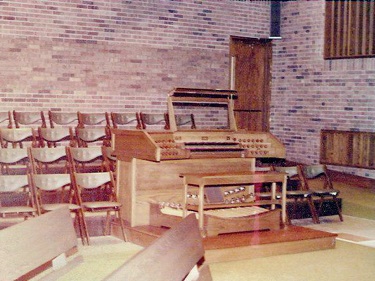|
Builder: Lawrence Phelps & Assoc, 1978 Manuals: 2 Ranks: 40 Action: Electric slider Notes: Identified by former organist Richard C. Greene. 12/2008 There is no visible facade -- the entire organ is behind a screen (Richard Greene, 2020). GREAT 16' Quintade 61 8' Principal 61 8' Rohrflöte 61 4' Oktav 61 4' Spitzflöte 61 2.2/3' Nasat 61 2' Waldflöte 61 1.3/5' Terz 61 1.1/3' Mixtur IV 244 8' Trompete 61 4' Klarine 61 SWELL 8' Viola 61 8' Viola Celeste 61 8' Gedackt 61 4' Prinzipal 61 4' Koppelflöte 61 2' Oktav 61 1.1/3' Quintflöte 61 2.2/3' Sesquialtera II 122 2/3' Scharf IV 244 8' Krummhorn 61 8' Oboe 61 Tremulant PEDAL 16' Subbass 32 8' Prinzipalbass 32 8 Gemshorn 32 4' Choralbass 32 2' Mixtur IV 128 16' Fagott 32 8' Trompete 32 4' Rohrschalmei 32 |
 |
 |
|
 |
|
|
John F. Shawhan, a Phelps associate writes about the Arlington
organ in regard to having 40 ranks on only two manuals: A significant mark and one that continues to this day with some builders, is the too early subdivision of the total tonal resources. I call this the “three-manual syndrome.” (Sometimes brought about by congregational one-upmanship?) When too few stops are spread thin over three (or four) manuals and Pedal, the number of redundancies in fundamental tones multiplies, and no one division can be complete. Thus, couplers become essential to performance, while many wonderful organ colors have to be omitted. A tonal design that is essentially dependent on couplers (or borrowings) is at rock bottom. Those who understand the organ’s nomenclature will perceive from the stoplist that in the design of Arlington's instrument, the Swell division is really an expressive Positiv, and that the design as a whole returns to the principles of the North German organ of 1700, each division complete with its choruses of principals and upperwork, and traditional reeds, set neatly into contrast by the pervading “Work-principle”. This basically Germanic concept is extended to include some essentials for playing the French Classic literature by providing for the formation of cornets on each of the manuals, and the placement of a 4’ Klarine in the Great division. Finally, the string and celeste, and Oboe, of the Swell, open the door to the Romantic tradition, albeit only a crack. Within the limitations of thirty stops, the organ has, I think, the right stops at the right pitches in the right places to achieve the widest possible variety of musical effects. The organ’s beautiful sounds are not an end of themselves; the great composer of the past, present, and future. |
|